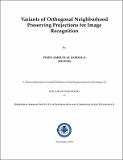Please use this identifier to cite or link to this item:
http://drsr.daiict.ac.in//handle/123456789/789| Title: | Variants of orthogonal neighborhood preserving projections for image recognition |
| Authors: | Mitra, Suman K. Koringa, Purvi Amrutlal |
| Keywords: | Dimensionality reduction Manifold learning Embeddings Neighbourhood Preserving Projrction (NPP) Orthogonal Neighbourhood Preserving Projrction (ONPP) Image recognition Face Recognition Text recognition Image reconstruction |
| Issue Date: | 2018 |
| Publisher: | Dhirubhai Ambani Institute of Information and Communication Technology |
| Citation: | Koringa, Purvi Amrutlal (2018). Variants of Orthogonal Neighborhood Preserving Projections for Image Recognition. Dhirubhai Ambani Institute of Information and Communication Technology, xii, 113 p. (Acc. No: T00752) |
| Abstract: | With the increase in the resolution of image capturing sensors and data storagecapacity, a huge increase in image data is seen in past decades. This informationupsurge has created a huge challenge for machines to perform tasks such as imagerecognition, image reconstruction etc. In image data, each observation or a pixelcan be considered as a feature or a dimension, thus an image can be represented asa data point in the very high-dimensional space. Most of these high-dimensionalimages lie on or near a low-dimensional manifold. Performing machine learningalgorithms on this high-dimensional data is computationally expensive and usuallygenerates undesired results because of the redundancy present in the imagedata. Dimensionality Reduction (DR) methods exploit this redundancy withinthe high-dimensional image space and explore the underlying low-dimensionalmanifold structure based on some criteria or image properties such as correlation,similarity, pair-wise distances or neighborhood structure.This study focuses on variants of one such DR technique, Orthogonal NeighborhoodPreserving Projections (ONPP). ONPP searches for a low-dimensionalrepresentation that preserves the local neighborhood structure of high-dimensionalspace. This thesis studies and addresses some of the issues with the existingmethod and provides the solution for the same. ONPP is a three-step procedure,in which the first step defines a local neighborhood followed by the secondstep which defines locally linear neighborhood relationship in high-dimensionalspace, the third step seeks a lower-dimensional subspace that preserved the relationshipsought in the second step.The major issues with existing ONPP technique are local linearity assumptioneven with varying size of the neighborhood, strict distance based or classmembership based neighborhood selection rule, non-normalized projections orsusceptibility to the presence of outliers in the data. This study proposes variviiants of ONPP by suggesting modification in each of these steps to tackle abovementioned problems that better suit image recognition application. This thesisalso proposes a 2-dimensional variant that overcomes the limitation of NeighborhoodPreserving Projections (NPP) and Orthogonal Neighborhood PreservingProjections (ONPP) while performing image reconstruction. All the new proposalsare tested on benchmark data-sets of face recognition and handwritten numeralsrecognition. In all cases, the new proposals outperform the conventionalmethod in terms of recognition accuracy with reduced subspace dimensions.Keywords: Dimensionality Reduction, manifold learning, embeddings, NeighborhoodPreserving Projection (NPP), Orthogonal Neighborhood Preserving Projections(ONPP), image recognition, face recognition, text recognition, image reconstruction |
| URI: | http://drsr.daiict.ac.in//handle/123456789/789 |
| Appears in Collections: | PhD Theses |
Files in This Item:
| File | Description | Size | Format | |
|---|---|---|---|---|
| 201321010_Purvi Amrutlal Koringa.pdf | 201321010 | 4.15 MB | Adobe PDF |  View/Open |
Items in DSpace are protected by copyright, with all rights reserved, unless otherwise indicated.
